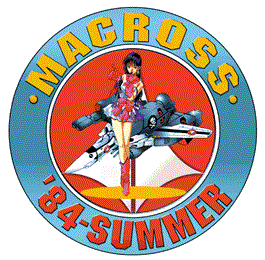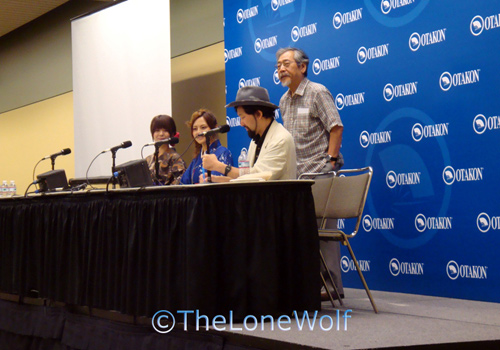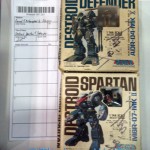Last year, Noburo Ishiguro attended Otakon 2011, so I decided to report on some of his activities at the convention. One of the events that he was participating in was a Q & A session, so Mechamaniac and I decided to solicit Macross World members for questions to ask him. We only got one question, and that was from Xard. As it would turn out, there was only enough time to ask Ishiguro one question, so it worked out perfectly. Xard wanted to know if Ishiguro stood back and let Shoji Kawamori have full reign over Macross: Do You Remember Love?, or if the movie was a collaborative effort between the two. A good question since both men are credited as the directors of the movie, but fans don’t know who exactly did what.
Also included in my report is the complete transcript of Ishiguro’s speech and Q & A session, as well as my account of his autograph session, and the items that he donated to Otakon’s charity auction for the 2011 Japan Relief. One of which was a Macross watercolor sketch by Haruhiko Mikimoto. I do not believe that this particular watercolor sketch has ever been published in any art book or magazine.
Click on the jump for the complete report and pictures.
On the weekend of July 29th, 2011, Noburo Ishiguro, credited as the director of anime such as The Super Dimension Fortress Macross, Megazone 23, and Tytania, attended the three-day anime convention, Otakon. Ishiguro
attended Otakon to premiere his latest project, Angel ScandyS. Ishiguro was accompanied by three of the show’s voice actresses: Orine Fukushima, Momoko Ohara and Chiaki Shimogama. Ishiguro had heard that Otakon was holding a charity auction in order to help raise funds for the 2011 Japan Relief, and in an unannounced move, donated several items from his own personal collection to be auctioned off.
July 29, 2011
On this day, Noburo Ishiguro was holding an autograph session that was attended by several fans. Initially, I went to the wrong room and was wondering why there wasn’t any autograph session going on, but then, in walked Ishiguro and his personal interpreter and they had the same confused look as me. Fortunately, a staffer told us where the autograph session was actually being held. It was awfully tempting to try to start up a small conversation with Ishiguro, but I didn’t want to put him in the awkward situation of having to choose between talking to a fan versus getting to his own autograph session on time. Once I got to the autograph session, there was already a long line of fans queued up. The majority of the items to be signed were from The Super Dimension Fortress Macross and Robotech, with Space Battleship Yamato and Megazone 23 rounding up the next tier of popular items. Ishiguro seemed surprised when I asked him to sign my DVD box set of The Super Dimension Century Orguss. Perhaps he was surprised to see it pop up in an autograph session or that it was actually licensed in the USA at one point in time.
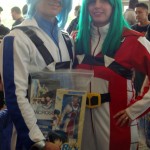
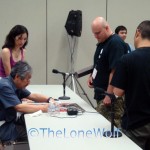
Later in the day, Ishiguro participated in a Q & A panel for Angel ScandyS. Unfortunately, I was not able to attend due to prior commitments.
July 30, 2011
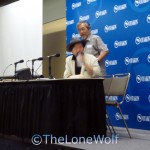
Today, Noburo Ishiguro held a panel in which he delivered a light-hearted speech on his early days in the anime industry and pioneering in animation, then followed it up with a question & answer session. Prior to stepping onto the stage to deliver his speech, Masao Maruyama was holding his own panel in the same room, which Ishiguro refers to in his opening remarks. After Ishiguro’s panel was over, he stuck around to take pictures with every fan who wanted one.
Noburo Ishiguro’s speech is copyright Noburo Ishiguro.
The Question & Answer transcript appears with permission from the Otakon panels staff.
Interpreter: Takayuki Karahashi
Adapted by: TheLoneWolf
“In the previous panel, Masao Maruyama was saying that the history of animated shows on Japanese television will mark it’s 50th anniversary two years from now. I began working in the anime industry in 1963, the year that the televised broadcast of animation started, so that will mark my 50 year anniversary in the anime industry. Back then, the public wasn’t aware of what ‘anime’ was, but they would get the idea of if you said ‘manga on film.’ In retrospect, it does feel like we were cutting out a pathway in a big forest. And 50 years later, it seems like that pathway has turned into a major highway that the entire world recognizes.”
“But even back then, we highly respected those who were the first ones to make an attempt at something new, because we also saw how hard it was to be the first ones there to try out something. For example, one of our role models was Walt Disney. He worked on something back then that was considered impossible: to make the feature length animated film that was Snow White and the Seven Dwarfs. And that was long before I was born by a couple of years, so that preceded my time. Back then, animated films were only short reels, like Mickey Mouse, that were shown before the actual feature film in theaters. And I hear that those animated shorts were popular in their own respect. But he (Walt Disney) wanted to make an animated film that would stand up to the test of an audience on its own. People around him said that it would be crazy to just show one hour of animation to an audience, and that it would be impossible. But Disney sought financing and went ahead and made Snow White. I read that he ran out his budget in the middle of production, so he had to take the dailies to the bank and show it to the execs there in order to get more loans to complete the financing. If Snow White was a commercial failure, there would’ve been no Disney from then on. But Snow White opened on Christmas Eve and there was an audience wrapped around the block to see it, so evidently that was something that led to today’s success of animation.”
“I also heard that the original Disney studio that Walt Disney made had no corners between the walls and floor, that they were all rounded. And apparently this was to prevent dust from being collected in the corners, because he was planning on selling his studio to a hospital in case his venture failed. When I read up on stories of pioneers like this, I realize that there are a lot of hardships, and that there are a lot of very inventive endevours today that won’t make it.”
“Let me tell you another example of what it’s like (to be a pioneer). I have a friend by the name of Toru Miura, he is the president and founder of a studio called AIC. This was over 20 years ago; one day he just suddenly showed up and said ‘I have a new film to show you, can you take a look at it?’ We were using actual film back then, so we put the film up on the projector. This was the very first independent production that he made at AIC and it was a title called Cream Lemon [audience laughter]. ”
“Back then, something like Cream Lemon was unprecedented as an animated work, and AIC was trying to come up with something new, so that was the new anime genre that they tried. But when Miura went around his studio and asked his animators to work on it, none of the animators actually wanted to do that and they all turned down his request [audience laughter]. So, in desperation, he had to go to, not the key animators, but the in-between animators, the young ones, and ask them if they could do it. Since they were in-between animators, they jumped at the chance to do key animation.”
“Since these were very young animators who were inexperienced with the affairs of the content [audience laughter], they had to study lots of books and go out [more audience laughter]. On the affairs, when you look at Cream Lemon, you can tell that they did a lot of research [even more audience laughter]. But even though they worked hard in their research, the actual animation itself is not very fluid. You can’t tell there’s any sense of tenderness, so it doesn’t really invoke much libido when watching it [audience laughter]. And the film that Miura brought was still in its uncensored form, so all the details were in there as well. Despite being explicit, it still didn’t invoke much reaction in the libido department. Even though the result was disappointing, I could tell that they really worked hard at it and that their effort showed in the film; that got to me and I liked the film for that.”
“Back then, all the production was done by cels, and those cels needed to be painted. Most cell painters were young women, and most of them turned down the job [audience laughter]. So he (Miura) went around enlisting retired cel painters, those who got married and were raising families, to come back to work. These were the ones who said ‘yes’ and came back to cel painting. Now certainly, it feels weird to be working on something like that for the first three days. But after that, you get used to it and it just turns into a job. As you know, titles like Cream Lemon feature characters who are mostly naked, so there aren’t any costumes that you have to worry about [audience laughter]. So the painting job is actually very easy; you just do skin tone and then shadows. Once they realized how easy it was to paint these cels, they wanted more of it [audience laughter].”
“And so that was how the very first Cream Lemon was made. It was actually briefly successful, so they made more of it, a part 2 and part 3. And then, when the first animators and the people who turned down the initial offers for work saw that kind of success, they came back and said ‘We want in as well.’ And it was fairly difficult, what happens when the pioneering work turns out to be successful. Today, a lot of adult animation, 18 and over DVD’s, are pretty common. But I do commmend the pioneers who attempted to create the very first work that was to be the mounting piece of this genre.”
“By that context, one of our shows, Space Battleship Yamato, was also somewhat a bit of a first because it was one of the first animated science-fiction shows in Japan. Since I always had a love for science-fiction, I was very happy to join the team that was going to make science-fiction anime. Science-fiction is full of tall-tales, so the most important part of making science-fiction is to make it realistic. And since this is the medium of animation, we wanted to make something that looked very new. So I put in every single idea that I’d been keeping, or came up with, into the production of Yamato.”
“Initially, Space Battleship Yamato was going to be hardcore, all 100% science fiction. But later in the series, it starts to change in nature and becomes more of a love-conquers-all story. That especially became more prominent in the Yamato film features. The producer (Yoshinobu Nishizaki) of Yamato was someone who was very keen on catching on to that trend, so he really incorporated that into his later features. And thanks to that kind of pioneering effort in Yamato, that seems to be the current trend in a lot of animated features; you do feel overwhelmed by that today. However, having worked right next to this producer, I know that he doesn’t have a complete love for humanity. The only kind of love that I’ve known him to have shown was love for the fairer sex [audience laughter]. So I knew that he wasn’t being sincere (in Yamato).”
“Before I became a director, I was an animator and I was especially fond of doing FX animation. So what I specialized in as an animator wasn’t character animation, but effects, and a lot of unnatural objects. I put a lot of that knowledge into the production of Yamato as well. Explosions in space is something that I spent a lot of time contemplating and had fun with, as well as a lot of hard time spent doing it. And subsequently in The Super Dimension Fortress Macross, an animator by the name of Ichiro Itano took over that role and he invented a lot of animated acrobatics dubbed as the ‘Itano Circus,’ and that was a kind of special effect that was invented and put into animation. There was an animator by the name of Hideaki Anno who was also working on Macross and later on, he went on to direct his own shows, such as Neon Genesis Evangelion; you can see the kind of effects that he learned and invented for Evangelion in each robot’s actions.”
“Since then, there have been a lot of other young effects animators, but today a lot of the effects are done by CGI. So I think there hasn’t been much room for individual talent to shine; I feel a little sad about that. I think future films will be more close to a Hollywood style, where there would be an image artist and a cgi operator collaborating their work to come up with visual effects. So sometimes I reminisce about the days working on Yamato, where everything was hand-drawn, one sheet at a time.”
“Our producer from Yamato passed away last fall and a lot of us old-timers who worked on Yamato were saying that perhaps we should get together this fall for the one-year memorial; there’s a lounge to do that in Shinjuku called Loft/Plus One. So we were talking about getting together for a memorial, then one of the chief animators, Toyoo Ashida, passed away last week. And so another member from the Yamato team has become someone that we won’t see ever again. But I guess this is something that’s inevitable. I’ve been in the anime industry for 50 years, and that’ll eventually include myself as well. I’ve been wondering how long I can keep on coming here myself.”
“I heard that there’s a charity auction at Otakon and that its proceeds are specifically going to the Japan Relief, so I brought a lot of stuff from my studio. There’s a lot of toys, memorabilia and artwork displayed down there right now, so you can go there and make a bid. It’ll make everyone happy.”
“I didn’t want to get too somber, but a lot of people ask me what I’ve been doing recently. Actually, I haven’t been doing much. And that gets boring as well, so I wanted to get started with something new, a new project. I’ve brought the voice actors who are part of that new project (Angel ScandyS) and want to introduce them to you later. But I think they are signing at 1pm today, so that’d be one chance to see the voice actors while they’re out.”
“If anyone has any questions or comments for me, I’d be happy to answer them.”
Attendee 1: Thank you very much for your work. I grew up in Detroit, in a very nice area and a lot of films, like Yamato and Macross, really opened up my world as a child, and I appreciate that. One thing that was popular that I noticed was the concept that ‘only fools rush into war’ is used in stories told in the future to teach people about the lessons of the past. Why was that so important to you and do you think that message got across?
Ishiguro: One of my own confounding experiences was seeing Tokyo burnt to a crisp by American carpet bombing. I was born and raised in Tokyo, so I’ve seen Tokyo from it’s very bottom to what it is today. And it’s been my lifelong experience that war is just nothing for good. About two or three years ago, there was a television documentary about how and why Japan started the war in the Pacific. The testimonials of the politicians and military leaders back then show that it really was a sloppy haphazard thought process and it only convinced me that if you heed what policitians say, then things will get worse. It was really thanks to the American power that militaristic Japan was defeated, and thanks to that, I have the freedom to enjoy what I do today. For that, I do have an appreciation for American culture. Thank you for your support.
Attendee 1: How do you keep your passion to continue to work in the field of what you’re doing after so many years, and do you believe that todays’ animators, with the increases in technology that they now have at their hand, would’ve been able to make it and survive in the days when you first became an animator?
Ishiguro: Well, if you sent today’s animators forty or fifty years back in time, they would all probably quit [audience laughter].
Attendee 2: Yes, I was wondering, I heard that before Yamato, it was difficult, if not impossible, to get an anime tv series produced and set in outer space because the sponsors, or whoever made those decisions, felt that the backgrounds would be too boring. Any proof to this story?
Ishiguro: That’s very true and that’s something that I’ve said before. Sponsors were actually saying that in space, the background is only starfields, so children will be bored when they see that.
Attendee 3: Is there any information on Legend of the Galactic Heroes, either new releases or if it’s ever coming to the Americas?
Ishiguro: One thing not to expect out of Legend of the Galactic Heroes is any new novels [audience laughter]. Just recently, Legend of the Galactic Heroes was made into a stage production and that was a fairly good success, so I’ll venture to say that they’re going to continue with that style for now. If there’s going to be any new production of Legend of the Galactic Heroes, that will not involve me. I have my own projects that I would like to work on, so that’s going to be my future.
Attendee 4: This is not really a question, but I’d just like to let you all know that I was in Japan back in 1963. I was only 6 years old and I did actually watch the first broadcast of Tetsujin Atom, you know, Astro Boy and Tetsujin, as Gigantor and 8 Man on TV. And to me, I thought that was great and at that time, I just thought that the animation, to me, was about the same as it was like, Popeye and The Flintstones there. I also thought it was awesome to see shows like Popeye and The Flintstones on Japanese TV.
Ishiguro: From my perspective, Popeye had much more fluid animation (compared to anime); it was more animated.
Attendee 5: When you were last here, you spoke of the need for the establishment of an anime archival system to preserve the works that had been produced over the last century and to preserve works for future generations. Are there any new developments that we may not be aware of in the United States since you were last here, in terms of the establishment of such a system. And, how can we, as fans in the United States, support anime archival efforts?
Ishiguro: There might be some progress, because I’ve heard that the Japanese government was interested in financing such an archival system. So I guess that’s minor progress.
Attendee 6: I don’t know if you remember this or not, but in the middle of the production of the Legend of the Galactic Heroes, they produced the Golden Wings OAV series, and it was such a strange anamoly, that it had a completely different cast and crew. [Attendee 6 now looking at the interpreter] What does he know what the intended reason for this, like who were they trying to court for this very different style of animation and direction? And I was gonna just like to say, I thank that they went back to his team to finish off the series.
Ishiguro: That was something that the publisher decided to do. Oh, but before that, Legend of the Galactic Heroes was made into a manga based on the novels, and I don’t know why or how they decided to an OAV based on the manga. That stands out as a unique piece since the character designs, and even the cast, are different. Apparently, it wasn’t too popular with LoGH fans, but I don’t have much information about that.
Attendee 7: Mr. Ishiguro, you and Shoji Kawamori are both credited as the directors of Macross the Movie, so my question is: how did you two divide the directing duties?
Ishiguro: My involvement was mostly in preproduction. The initial phase was where I helped out the most. The rest, such as mecha designs, story development, were efforts by Shoji Kawamori; and not only him, but other young animators, such as Ichiro Itano and Haruhiko Mikimoto. It was their collaboration and cooperative effort. So at that point, I wasn’t too involved with the hands-on work of production.
Attendee 8: [speaking in Japanese] My name is (name withheld). [now speaking in English] So if it’s ok, I’ll use English. I read a lot of reference books regarding Japanese animation so I could learn about the creation of Japanese animation. If it’s not too much work, I was thinking if it would be possible to make a lot of reference material regarding the productions of how you did most of your work, and also current works too. It would be a big help for me to understand the process that goes into the production of feature films, and also series.
Ishiguro: Do you have any specific titles in mind?
Attendee 8: [garbled microphone feedback, something about Macross]
Ishiguro: There are several Macross production reference materials that’ve been commercially published. You can find big tomes for Macross.
Attendee 8: Oh, not just Macross, but like a general book.
Ishiguro: I think there might some for LoGH, but as for the rest, I don’t know what they’ve published.
Attendee 9: [speaking in Japanese] Good morning, Noburo-san. So, what’s your favorite movie? Excuse me.
Random Audience Member: Could you repeat that in English?
Attendee 9: [addressing the Random Audience Member] What’s his favorite movie.
Ishiguro: There are too many too list. But for science fiction, perhaps I could say 2001: A Space Odyssey. I confess that I’m also very fond of old Hollywood musicals and I’ve pretty much seen all of them. This is something that I’ve never told other people, but I’ve always choreographed space battles thinking that they were musical numbers in space [audience laughter]. This is so secret that I’ve never confessed it to anyone else. That’s as much as I’ll say [audience laughter].
Interpreter: Ok, 45 seconds left to our panel.
Attendee 10: What are some of the most significant challenges or problems that you believe to creating a dub for Legend of the Galactic Heroes in English?
Ishiguro: Is there an English dub?
Attendee 10: No.
Ishiguro: I don’t know what the obstacle might be, but if anyone is interested in financing a venture, I hope that it actually happens. I think that this is probably a problem involving financing, and the lack of financing is preventing a production.
Interpreter: It’s noon, our hour’s up, thank you very much for coming to this panel.
[audience applause]
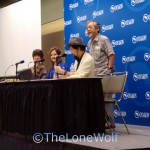
Ishiguro: Before we wrap up, I’d like to introduce a couple of people. [Orine Fukushima, Momoko Ohara and Chiaki Shimogawa appear on stage] I brought some cute voice actresses who are the talents involved in my current project. These two are Chiaki Shimogawa and Momoko Ohara. They play the leads in the animated title, Angel ScandyS. Normally, cast members are decided after an animated film has been made; but in this one, we reversed the process. We started with the principal cast and the characters are animated in the image of the voice actors. So perhaps we can wrap up by having the two of them say something to you.
Momoko Ohara: [speaking in English] Hi! [now speaking in Japanese] I’m Momoko Ohara, I’m a voice actor from Japan. I’m not really sure which way the project is going to go, but I’m very excited to know that the animated character will be based on me, so that’s what I’m looking forward to.
Chiaki Shimogawa: Konnichiwa!
Audience: Konnichiwa!
Chiaki Shimogawa: [speaking in English] My name is Chiaki Shimogawa. [now speaking in Japanese] I’m not very experienced as a voice actor yet, but I do have my own radio show. If you’d like, you can look me up on the Internet; I have a web page, so you’ll be able to find me there too.
Ishiguro: Their autograph session should be at 1:30, so please drop by and see them there. They’ll have a concert during the Masquarade half-time show tonight, so that should probably be around 8:30 tonight. Thank you for coming!
[audience applause]
July 31, 2011
On this day, Otakon held their Japan Relief charity auction for those affected by the Great East Japan Earthquake of March 11, 2011. Several members of the anime industry and convention guests donated items to be auctioned off, including Noburo Ishiguro. Though, Ishiguro did not attend the auction itself. Most likely because its scheduling conflicted with a panel of Japanese Directors / Producers that he was participating in. Unlike many of the other items’ patrons, Ishiguru did not give Otakon any advance notice that he was going to be bringing items to donate, which left the Otakon staff scrambling to spread the news of his donations. All the items that Ishiguro brought from Japan were from his own personal collection. The Macross toys that he brought were all from manufacturer Takatoku Toys. They included a 1/144 scale Destroid Defender, a 1/144 Destroid Spartan, and a transformable 1/3000 SDF-1 Macross. From model kit manufacturer IMAI, he brought an unbuilt 1/100 Glaug. From Orguss, he brought a transformable 1/40 Orguss, also from Takatoku Toys. All these items were signed by Ishiguro himself.
The final item that he brought was a Haruhiko Mikimoto watercolor sketch from the early production days of The Super Dimension Fortress Macross. Featured in the sketch are main characters, Hikaru Ichijo and Misa Hayase. What’s notable about this sketch is that the version of Hikaru Ichijo presented bears little resemblance to the final version of Hikaru that was shown in the actual animation. This early version of Hikaru more resembles the hero from The Super Dimension Century Orguss, Kei Katsuragi. Since Mikimoto was the chief character designer for both anime series, he probably recycled this unused character design into Orguss.
The 1/144 Destroids were auctioned off as a pair and sold for $140. The 1/3000 SDF-1 Macross sold for $1,100. And the Haruhiko Mikimoto sketch sold for a staggering $9,100. According to the auctioneer, this item was the highest that any auction has ever sold for in the history of Otakon. Unfortunately, I could not stay the entire time and see what the 1/100 Glaug and 1/40 Orguss sold for because the auction was beset by delays and had charity auctions mixed in with for-profit auctions, which resulted in the event exceeding its time slot by several hours. All in all, the charity auction was a success and raised over $65,000 for the 2011 Japan Relief.
After the convention was over, Ishiguro joined the Otakon staff for a post-con celebration at the Hyatt Regency hotel.
